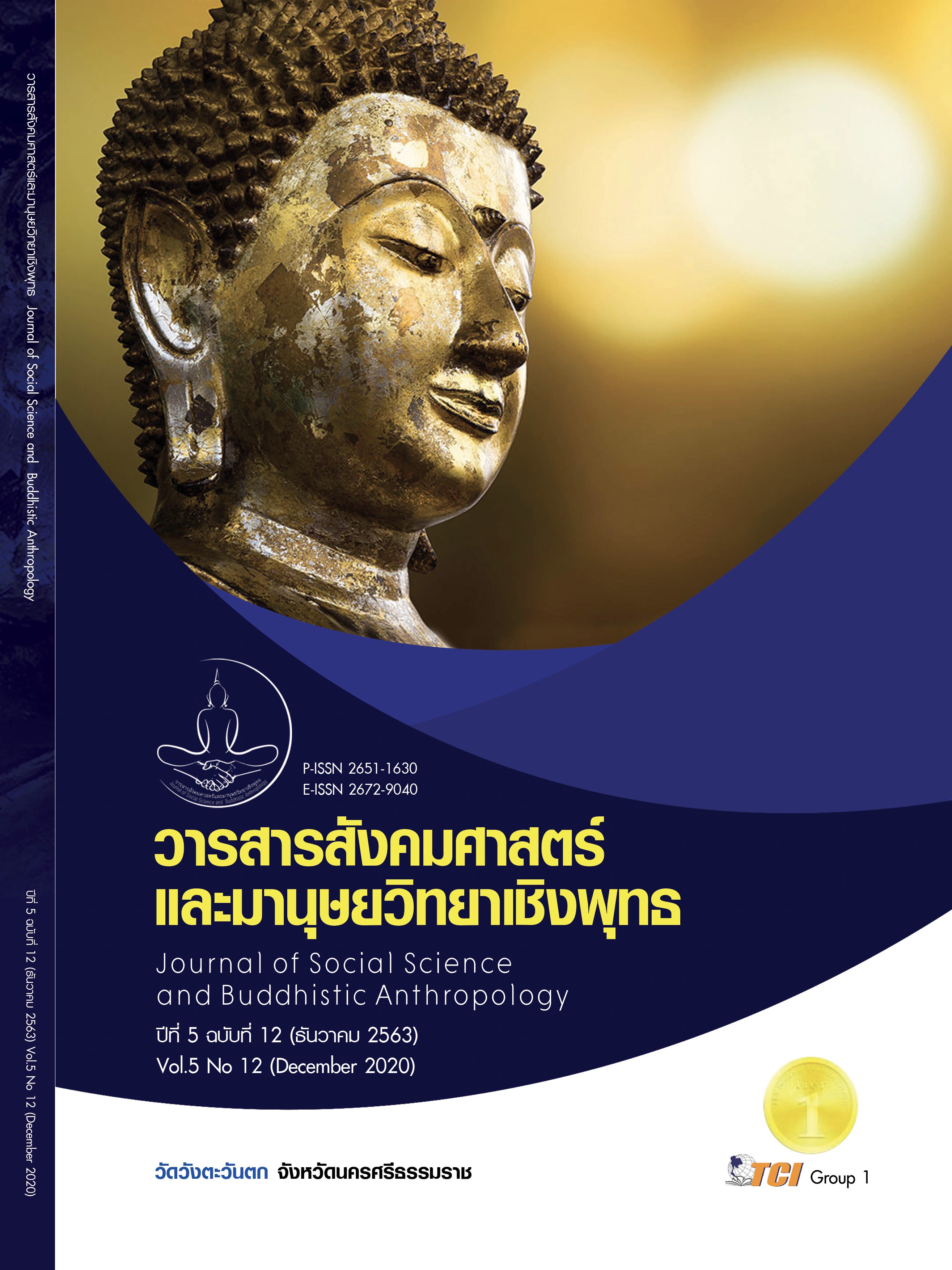THE DEVELOPMENT OF MODEL FOR PREPARING PRE-VOCATION SKILLS FOR AUTISM TRANSITION FROM SCHOOL TO WORK
Keywords:
Model for Preparing for Working, Transition from School to Work, Autistic ChildrenAbstract
The objectives of this research article were 1) to investigate the present situation, problems, and expectations for preparing the pre-vocational skills for children with autism during the transition from school to work, 2) to create a model outline for preparing the pre-vocational skills for autism during the transition from school to work. This research is a qualitative research, the target groups comprised of the special education teachers or other teachers responsible for the projects of inclusive schools, parents, and representatives from business sector. The tool of the research was the structured interview dealing. Data ware analyzed by means of content analysis. The research results were found that 1) Regarding to current situation, it was found that the school was mainly responsible of raising awareness and organizing learning activities for supplementing skills in the existing curriculum for children with autism. Also, the parents supported activities as requested by the school, and helped train their children living skills. In addition, business sector had to comply with the law for accepting children with autism to work. Regarding to the problems found in these 3 groups, there was a lack of knowledge and understanding of pre-vocational skills and the preparation of transitional plans. Both school and families agreed that there should be a clear and easy-to - use guideline for working skills preparation. However, the business sector expected children with autism to be prepared for basic work skills and to be able to live with others. 2) Regarding to the model outline for preparing pre-vocation skills for children with autism transition from school to work, there were two integrated components: 2.1) The transition from school to work for children with autism and 2.2) Pre - vocation skills preparation. This model reflected a collaboration among the family, the school, and the business sector want to autism has the necessary skills during the transition from the school to work.
References
ทวี เชื้อสุวรรณทวี และคณะ. (2558). โอกาสในการทำงานที่เหมาะสมกับความพิการ = Employment opportunities for persons with disabilities. ใน รายงานการศึกษากิจการเพื่อสังคมไนส์คอร์ป. วิทยาลัยราชสุดา มหาวิทยาลัยมหิดล.
พิไรสรร จินดาสวัสดิ์. (2558). การเพิ่มขีดความสามารถในการประกอบอาชีพให้คนพิการ. ใน วิทยานิพนธ์หลักสูตรประกาศนียบัตรชั้นสูง สาขาการบริหารเศรษฐกิจสาธารณะสำหรับนักบริหารระดับสูง รุ่นที่ 14. สถาบันพระปกเกล้า.
เมฆินทร์ เมธาวิกูล และคณะ. (2556). รายงานฉบับสมบูรณ์โครงการการส่งเสริมอาชีพและการมีงานทําของคนพิการตามพระราชบัญญัติส่งเสริมและพัฒนาคุณภาพชีวิตคนพิการ พ.ศ. 2550. ใน รายงานการศึกษาฉบับสมบูรณ์. มหาวิทยาลัยสยาม.
สมเกตุ อุทธโยธา. (2560). การเรียนรวมสำหรับเด็กที่มีความต้องการพิเศษในโรงเรียนปกติ. (พิมพ์ครั้งที่ 13). เชียงใหม่: ส.อินฟอร์เมชั่นเทคโนโลยี.
อัญชลี สารรัตนะ. (2559). ลักษณะงานและอาชีพที่เหมาะสมกับบุคคลกลุ่มอาการออทิสซึมวัยทำงาน. วารสารวิทยาลัยราชสุดา, 1(15), 89-100.
อัญชลี สารรัตนะ และคณะ. (2558). สภาพปัจจุบันความต้องการด้านอาชีพและกรณีศึกษาบุคคลออทิสติก. วารสารวิทยาลัยราชสุดา, 12(15), 22-42.
American Psychological Association. (2000). Encyclopedia of Psychology. Retrieved August 25, 2020, from from http://www.apa.org/topics/autism/index.aspx.
Blalock, G. et al. (2003). The need for comprehensive personnel preparation in transition and career development: A position statement of the division on career development and transition.Career Development and Transition for Exceptional Individuals, 26(2), 207–226.
Brzinsky-Fay, C. (2014). The measurement of school-to-work transitions as processes. European Societies, 16(2), 213-32.
Burke, R. V. et al. (2010). Evaluation of two instruction methods to increase employment options for young adults with autism spectrum disorders. Research in Developmental Disabilities, 31(1), 1223 –1233.
Carew, D. et al. (2010). Employment, policy and social inclusion. The Psychologist, 23(2), 28 – 30.
Centers for Disease Control and Prevention. (2014). Prevalence of autism spectrum disorder among children aged 8 years: autism and developmental disabilities monitoring network. Morbidity and Mortality Weekly, 63(SSO3),1-21.
Geraldine, S. et al. (2020). Transition(s) to work: the experiences of people with disabilities in Ireland. Disability & Society, 35(10), 1556-1576.
Gerhardt, P. F. & Lainer, I. (2011). Addressing the needs of adolescents and adults with autism: A crisis on the horizon. Journal of Contemporary Psychotherapy, 41(1), 37– 45.
Hendricks, D. (2010). Employment and adults with autism spectrum disorders: Challenges and strategies for success. Journal of Vocational Rehabilitation, 32(1), 125–134.
Jan, R. et al. (2010). Planning Life After High School for Students on the Autism Spectrum: A Guide for Tennessee Families. Retrieved August 23, 2020, from https://vkc.mc.vanderbilt.edu/assets/files/resources/transition.pdf
Kallio, A. & Owens, L. (2004). Opening Doors to Postsecondary Education and Training: Planning for Life after High School, a Handbook for Students, School Counselors, Teachers, & Parents. Journal for Vocational Special Needs Education, 26(3), 23 - 41.
Karrie, A.S. et al. (2012). Transition Planning for Students with Intellectual Disability, Autism, or Other Disabilities: Data from the National Longitudinal Transition Study-2. Intellectual and Developmental Disabilities, 50(1), 16–30.
Kellems, R. O. & Morningstar, M. E. (2012). Using video modeling delivered through iPods to teach vocational tasks to young adults with autism spectrum disorders. Career Development and Transition for Exceptional Individuals,, 35(1), 155 –167.
Lugnegård, T. et al. (2011). Psychiatric comorbidity in young adults with a clinical diagnosis of asperger syndrome. Research in Developmental Disabilities, 32(1), 1910 –1917.
Migliore, A. et al. (2014). Trends in vocational rehabilitation services and outcomes for youth with autism: 2006 - 2010. Rehabilitation Counseling Bulletin, 57(1), 80 –89.
NCWD/Youth. (2012). Helping Youth Build Work Skills for Job Success: Tips for Parents and Families. Retrieved August 25, 2020, from http://www.ncwd-youth.info/wpcontent/uploads/2016/11/infobrief_issue34.pdf
Scanlon, G. et al. (2013). Changing attitudes. Supporting teachers in effectively including students with emotional and behavioural difficulties in mainstream education. Emotional and Behavioural Difficulties, 18(4), 374-395.
Sonne, T. (2009). Ashoka Ireland World Leaders in Social Innovation. Retrieved August 25, 2020, from http://ireland.ashoka.org/fellow/thorkil-sonne.
Turnbull, H. et al. (2004). The Individuals with Disabilities Education Act as Amended in 2004 . Upper Saddle River, New Jersey: Pearson Education.
Vogeley, K. et al. (2013). Towards the development of a supported employment program for individuals with high-functioning autism in Germany. European Archives of Psychiatry and Clinical Neuroscience, 263(S2), 197 –203.
Vondracek, F. W., & Porfeli, E. J. (2006). The world of work and careers. In G. R. Adams & M. D. Berzonsky (Eds.), Blackwell handbook of adolescence (pp. 109 – 128). Malden. MA: Blackwell.






